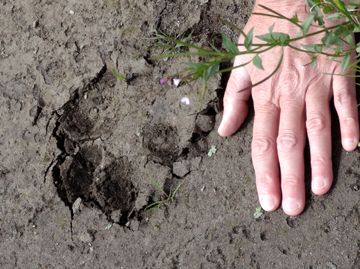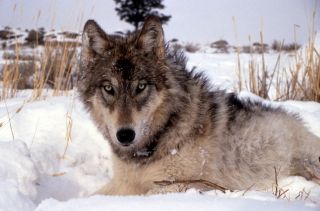
Fear
Who's Afraid of the Big Bad Wolf?
Conservation and lifestyles come into conflict
Posted September 11, 2012
Apparently, we are. That’s “we” as in we humans. Remember "Little Red Riding Hood" or "Three Little Pigs?" Those and similar stories express a deep fear of wolves. They come mostly from Europe, with our immigrant ancestors. And those stories have made their way into the folk tales, literature, films, and thinking of many modern people who have never ever seen a wolf. In fact, cases of wolf attacks on humans are very rare in North America, and somewhat less rare in Europe and Asia.
How afraid are we? Very.
The gray wolf was once the most widespread (nonhuman) predator in the world, inhabiting all of North America and Eurasia north of about 20 degrees. By 1800, wolves were hunted and largely eliminated in Europe. In 1915, the United States followed suit by founding the federal Bureau of Biological Survey and its Division of Predator and Rodent Control with the express mission of exterminating wolves from federal lands. “Large predatory mammals, destructive to livestock and game, no longer have a place in our advancing civilization,” it was said.
By then, wolves were already in serious decline due to increasing settlement of the American West by Europeans in the 1860s to 1870s. Settlers had a widespread conviction that one key to solving the “problem” of the Plains Indians was to eliminate the buffalo or bison. Rampant and senseless slaughter of bison had the then-desirable effect of greatly reducing both wolves and Native Americans. In 1926, the last wild wolf was killed in the U.S., with the exception of a small population in northern Minnesota. The gray wolf had been “extirpated”—a euphemism for trapped, poisoned, shot, gassed, or any other method of killing you can think of.
The general feeling was that the only good wolf was a dead one. Wolves were perceived as dangerous killers that would attack livestock, pets, and humans. Though I personally think wolves are wonderful and feel strongly they must be preserved, I have also seen them on the hunt. They are consummate predators: fast, ruthless, deadly, and well-coordinated as a group. We are right to be scared. These are not cuddly puppy dogs. They are wild and free and very, very good at what they do. And what they do is kill to eat. Of course their howls send chills down our spines.
Decades passed before anyone even considered that exterminating the wolf might not have been a good idea. The publication of Farley Mowat’s extremely popular book Never Cry Wolf in 1963 began to change public attitudes. By 1974, the gray wolf was offered protection under the then-new Endangered Species Act in the U.S. The wolf killing stopped.
Amazingly, from 1995 to 1996, an experimental wolf reintroduction was carried out in Yellowstone National Park. Yellowstone is one of the last strongholds of wild bison and abundant other prey species including elk, moose, two species of deer, pronghorn antelope, and bighorn sheep. Thirty-one wolves from two different areas in Canada were released into the park. They recolonized the park itself (3,471 square miles), as well as the adjacent greater Yellowstone Ecosystem (another 28,101 square miles).
The experiment was one of the great conservation successes. The wolves have thrived in the Yellowstone ecosystem, which had gotten out of balance because of the elimination of its apex predator. With the reintroduction, which was closely monitored, the ecosystem has readjusted itself. Coyotes are markedly less common, because wolves have killed these competitors. Elk numbers are down, but still nobody could claim elk are uncommon. Vegetation once decimated by elk is growing tall again, providing better habitats for songbirds and small animals; beavers are back, damming rivers and creating ponds. Grizzly bears, ravens, and other scavengers have more carcasses to eat from, particularly in the dead of winter.
But what’s the problem? Wolves don’t know where the park boundaries are—and don’t care. They have expanded into nearby areas of Idaho, Montana, and Wyoming, as well as into Oregon, Washington and Utah. Some of this expansion may reflect wolves moving southward from Canada rather than coming from the reintroduced populations.
As predicted, wolves sometimes attack livestock, especially sheep and calves. Ranchers who have made a living off their livestock must now guard their animals, watch their pets and children, and sometimes face painful (and costly) losses of animals. There is a compensation program, but some ranchers regard it as a time-wasting exercise to obtain proper documentation of the loss, and others disdain it as “charity.” Little wonder you hear rumors of wolf problems being solved by “shoot, shovel, and shut up.”
The good news is that the gray wolf has done so well it has now been taken off the endangered species list (“delisted”) in Idaho, Montana, eastern Oregon, north-central Utah, eastern Washington, and Wyoming. The three states immediately adjacent to the park have pledged to manage wolf populations to meet a specific recovery goal of 30 or more breeding pairs (defined as an adult male and an adult female that raise at least two pups by Dec. 31 of a given year) and subpopulations comprising more than 300 wolves with genetic exchange between them.
The bad news is that wolf hunting season starts on Oct. 1in Wyoming, where regulations are particularly lax. Wolves outside Yellowstone National Park are fair game, and fully 68 percent of Wyoming’s 328 wolves live outside the park. Oh yes, there are regulations and permits for relatively small areas right next to the park. But how do you tell an amorphous group anxious to hunt a predator that they hate and fear that they may take only 52 wolves total? In most of Wyoming, wolves are designated as a predatory animal that can be taken without license, in any season, and by any method, including aerial hunting or gassing of wolf dens. Groups like Defenders of Wildlife view delisting as a disaster under these circumstances.
Will this system work? I don’t know. Emotions are running high in all directions.
Do you want to kill a wolf? They are beautiful and magnificent creatures, a striking symbol of the wilderness. Predators like wolves are essential to a healthy ecosystem.
But if a wolf killed your livestock or attacked a child? What then?

A wolf pawprint is as large as a human hand.

The gray wolf once inhabited the northern parts of North America and Eurasia.



